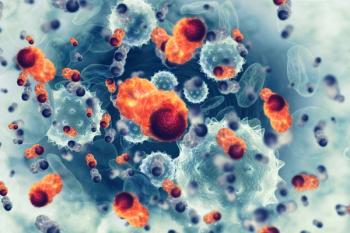
TAR-200 Improves Survival in BCG-Unresponsive, Papillary High-Risk NMIBC
Data from cohort 4 of the phase 2 SunRISe-1 trial demonstrate durable DFS with TAR-200 in BCG-unresponsive, papillary-only, high-risk non–muscle-invasive bladder cancer.
TAR-200 elicited durable disease-free survival (DFS) outcomes in patients with high-risk, Bacillus Calmette-Guérin (BCG)-unresponsive, papillary-only non-muscle-invasive bladder cancer (NMIBC), according to data from cohort 4 of the phase 2 SunRISe-1 trial (NCT04640623) presented at the
Findings demonstrated that at a median follow-up of 12.8 months, patients treated with TAR-200 (n = 52) experienced a median DFS that was not reached (95% CI, 12.1-not estimable [NE]). The 6- and 9-month DFS rates were 85.3% (95% CI, 71.6%-92.7%) and 81.1% (95% CI, 66.7%-89.7%), respectively. Notably, only 5.8% of patients underwent radical cystectomy.
“DFS rates were consistently high across both [patients with] high-grade Ta and T1 [disease], indicative of this [intravesical drug–releasing] system, [TAR-200], increasing the penetration of the drug [gemcitabine] across the bladder wall,” lead study author Felix Guerrero-Ramos, MD, PhD, an attending urologist at Hospital Universitario 12 de Octubre in Madrid, Spain, said in a presentation of the data.
Behind TAR-200 and Cohort 4 of SunRISe-1
TAR-200 is a novel intravesical drug–releasing system intended to provide sustained delivery of gemcitabine through all layers of the bladder wall.
SunRISe-1 is a phase 2 study evaluating TAR-200 in patients with BCG-unresponsive, high-risk NMIBC. Patients who had carcinoma in situ (CIS) with or without papillary disease were randomly assigned to cohorts 1 to 3; those with papillary-only disease were assigned to cohort 4.
Patients with BCG-unresponsive, high-risk NMIBC with papillary disease and no CIS enrolled to cohort 4 also needed to have a persistent or recurrent disease within 12 months of completing BCG, and they needed to be unresponsive to BCG without receiving radical cystectomy.
All patients enrolled in cohort 4 received TAR-200 monotherapy. The primary end point for this cohort was DFS; safety and tolerability were key secondary end points.
The median age at enrollment for cohort 4 was 71.0 years (range, 42-88); the majority of patients were male (71.2%), White (86.5%), and had an ECOG performance status of 0 (94.2%). Additionally, 55.8% of patients were former smokers, 13.5% were current smokers, and 30.8% were never smokers.
All patients had papillary disease that was stage Ta (59.6%) or stage T1 (40.4%). Patients received a median of 12 prior doses of BCG (range, 8-45), and the median time from the last dose of BCG to diagnosis of high-grade papillary disease was 2.8 months (range, 0.3-9.9). Prior to enrollment, 82.4% of patients had declined a radical cystectomy, and 17.6% were ineligible.
Additional Efficacy and Safety Data
When analyzed by disease stage, patients with high-grade Ta disease (n = 31) achieved 6- and 9-month DFS rates of 85.7% (95% CI, 66.3%-94.4%) and 82.1% (95% CI, 62.3%-92.1%), respectively. Among patients with T1 disease (n = 21), these respective rates were 84.7% (95% CI, 59.7%-94.8%) and 79.4% (95% CI, 54.0%-91.7%).
In the overall population, the median progression-free survival (PFS) and overall survival (OS) were both NE. The respective 9-month PFS and OS rates were 95.6% (95% CI, 83.5%-98.9%) and 98.0% (95% CI, 86.4%-99.7%). Only 1 patient experienced disease progression to MIBC.
Regarding safety, the majority of treatment-emergent adverse effects (AEs) were grade 1 or 1 and resolved after a median of 3.7 weeks. Serious treatment-related AEs (TRAEs) occurred in 5.8% of patients, and TRAEs led to treatment discontinuation in 7.7% of patients. No treatment-related deaths were reported.
Any-grade TRAEs occurred in 80.8% of patients, and the incidence of grade 3 or higher TRAEs was 13.5%. The most common TRAEs included dysuria (any-grade, 40.4%; grade ≥3, 0%), pollakiuria (30.8%; 0%), micturition urgency (26.9%; 0%), urinary tract infection (23.1%; 1.9%), hematuria (13.5%; 0%), bladder pain (9.6%; 3.8%), nocturia (9.6%; 0%), bladder spasm (7.7%; 0%), noninfective cystitis (7.7%; 0%), pruritus (7.7%; 0%), asthenia (5.8%; 0%), bladder irritation (5.8%; 0%), pelvic pain (5.8%; 1.9%), urinary incontinence (5.8%; 1.9%), and urinary tract pain (5.8%; 0%).
The ongoing phase 3 SunRISe-5 trial (NCT06211764) is evaluating TAR-200 vs intravesical chemotherapy in patients with BCG-unresponsive or -experienced, high-risk NMIBC with papillary-only disease.
“[SunRISe-5] will provide further evidence on the potential role of TAR-200 in this setting,” Guerrero-Ramos concluded.
In January 2025,
Disclosures: Guerrero-Ramos reported receiving grants/research funding from Combat Medical and Roche; consulting/advisory fees from AstraZeneca, Bristol Myers Squibb, Combat Medical, Janssen, Johnson & Johnson, Nucleix, Pfizer, and Roche; honoraria/speaker fees from Astellas, AstraZeneca, Bristol Myers Squibb, Combat Medical, Janssen, Merck, Nucleix, Palex, and Pfizer; and travel support from AstraZeneca, Ipsen, Janssen, and Pfizer.
References
- Guerrero-Ramos F, Jacob JM, Van der Heijden MS, et al. TAR-200 monotherapy in patients with bacillus Calmette-Guerin–unresponsive papillary disease–only high-risk non–muscle-invasive bladder cancer: first results from Cohort 4 of SunRISe-1. Presented at: 2025 AUA Annual Meeting; April 26-29, 2025; Las Vegas, NV.
- New drug application initiated with US FDA for TAR-200, the first and only intravesical drug releasing system for patients with BCG-unresponsive high-risk non-muscle-invasive bladder cancer. News release. Johnson & Johnson. January 15, 2025. Accessed April 26, 2025. https://www.investor.jnj.com/news/news-details/2025/New-Drug-Application-initiated-with-U.S.-FDA-for-TAR-200-the-first-and-only-intravesical-drug-releasing-system-for-patients-with-BCG-unresponsive-high-risk-non-muscle-invasive-bladder-cancer/default.aspx
Newsletter
Stay up to date on recent advances in the multidisciplinary approach to cancer.
















































































